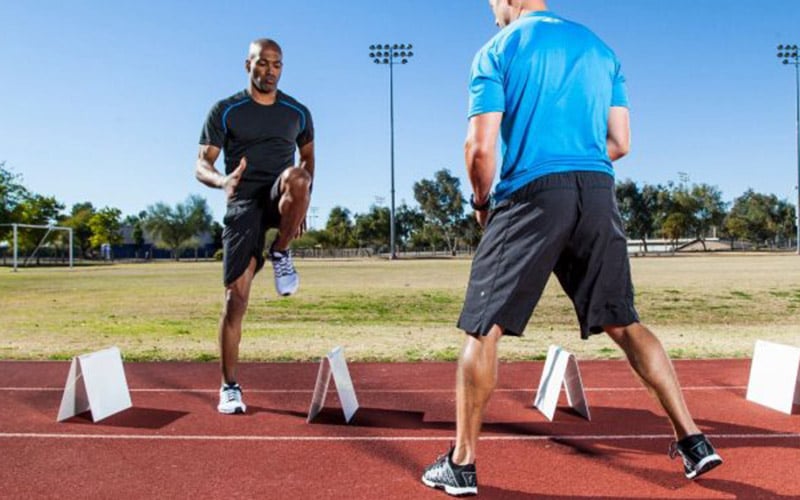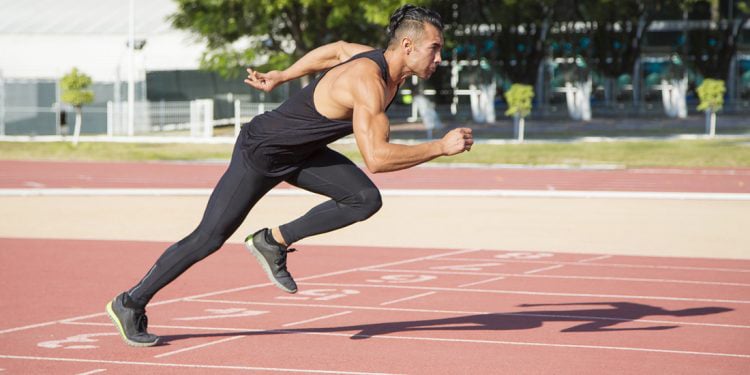Learning how to coach an athlete through strength and conditioning is far more complicated than training general population clientele and, arguably, more fulfilling. There are many more factors, modalities, thinking, and planning strategies involved with coaching an athlete of any magnitude – young, adult, novice, or elite.
Here are the 8 reasons why you, as a sports performance professional, should train athletes:
- Grow More Observant in Initial Meetings and Assessments
- Understand Sports-Specificity
- Learn 'Big Picture' Training
- Gain the Opportunity to Learn How to Optimize Programs Through Periodization
- Grasp How to Make Purposeful Exercise Selections for Athletic Clients
- Understand When to Select Acute Training Variables
- Recognize When to Incorporate Speed and Agility Training, Plyometrics, and Concurrent Training
- Achieve Immense Personal Growth
(1) You Become More Observant in the Initial Meeting and Assessment
When coaching athletes of any kind, the coach must consider several factors:
- The athlete's level of training experience
- Biological and chronological age
- Current physical condition
- Physiological and movement specific components of the sport they participate nutritional needs
- Injury history
- External life stressors
Internal and external forms of stress can profoundly impact adaptive progress and athletic performance. Thus, you should consider management and manipulation of both physiological and psychological stress when designing a training program for athletes.
When introduced to a new athlete, the coach should begin by learning the athlete's training, medical, and injury history and investigate their diet and social constraints that may influence training.
Following the interview process, the coach should guide the new athlete through a thorough movement assessment, collecting visual data on strengths and weaknesses for future corrective exercise implementation.
Moreover, research on the athlete's sport may be immensely beneficial before the coach begins his or her programming.
By evaluating the physiological components of the sport, such as intensity and duration of playtime, as well as the movements and anatomical positions frequently employed within the sport, the coach can gain a greater knowledge and understanding of what will improve performance outcomes in their new client.
From there, the coach can begin designing a program tailored to enhance the athlete's general and sport-specific strength, power, and conditioning, with consideration of the sports season/phase.
(2) You Learn and Implement “Sport Specificity” - Nothing is Random
The SAID Principle, “Specific Adaptations to Imposed Demands,” refers to the fundamental concept that the activities and/or training we participate, will induce highly specific adaptations related to the specific demands we consistently encounter.
When developing a program for an athlete, you should make attempts to connect the SAID principle with what occurs within the sport, to improve performance in practice and competition. We refer to this as "sport-specific" training. A sport-specific program takes into consideration the primary muscles, movement patterns, contraction phases, and joint actions observed during the sport in question.
It integrates a resistance training and conditioning program to promote such aspects further. While weight training cannot be entirely “sport-specific,” as participation in the sport itself will yield the most significant improvements, a sport-specific training program can build on adaptations that transfer into improved performance outcomes.
sport specificity in practice

When coaching and programming for athletes, we must place a considerable emphasis on what they specifically need to excel in their sport. As an individual or athlete performs exercise, the energy system(s) they utilize the most, will be the foundation of the adaptations they experience, hence why it is vital to consider the physiological components of the sport.
Whereas high volume aerobic training promotes mitochondrial biogenesis and protein synthesis in slow-twitch muscle fibers, lower volume, and high-intensity training stimulate adaptive alterations in fast-twitch glycolytic and oxidative-glycolytic muscle fibers 1.
Understanding evolving mechanisms in each energy system paves the way for inducing optimal training interactions and increasing athletic performance. Issurin (2019) explains that homeostatic regulation, stress adaptations, and supercompensation effects are fundamental to an effective training program 1.
What is supercompensation?
“Supercompensation” is described as the accumulation of adaptations following a training session or cycle, including biomechanical, structural, mechanical, metabolic, neurophysiological advancements, and the body's return to standard functional capacity at new homeostatic levels 2.
The type and intensity of exercise play a significant role in the magnitude of stress the athlete faces and the adaptive responses to follow 1.
Depending on the energy system largely at work during training, that system can give light to the adaptive responses the athlete will experience during the phases of supercompensation.
(3) You Look at the Larger Picture: Designing Annual Plans
When training athletes, coaches must consider where the athlete is in regards to the sports competition season. The annual training plan should be divided into four main phases: preparatory (off-season), first transition (pre-season), competition (in-season), and second transition (active rest).
Each of these phases consists of periodization models with specific performance outcomes that work off one another to develop an athlete's strength and athleticism for competition.
Utilizing the NASM OPT ™ Model for Athletes
The Optimum Performance Training Model (OPT), developed by NASM, breaks these phases up into subphases that emphasize corrective exercise, stabilization endurance, strength (further broken up into strength endurance, hypertrophy, and maximal strength), power (focusing on high force and high velocity with complex training schemes, followed by maximal power training for athletes who require such adaptations) 3.
The stabilization phase
prioritizes improvements in muscle imbalances, core muscle stabilization, preparation for skeletal muscle, and connective tissue to handle higher demands in later stages, includes a gradual increase cardiorespiratory and neuromuscular conditioning, and enhance anatomical movement patterns and exercise technique 3.
The strength phase
begins to build the athlete's maximal strength, through incremental increases in intensity (external load), coupled with decreases in volume 3.
Throughout this phase, the primary goals are to improve core muscle stability under heavier loads, increase load-bearing capacity in skeletal muscle and connective tissues, improve resistance to fatigue as the athlete moves into higher intensities by the third sub-phase, elevate metabolic demands on the ATP/CP and glycolytic systems, and enhance motor unit recruitment, frequency, and synchronization 3.
The maximal strength phase
This is arguably the most critical time for development for athletes, as maximal strength is the prerequisite for an enhanced rate of force development (RFD) 2,4.
Rhea et al. (2009) noted that RFD is likely more critical in force output than muscular strength alone, highlighting its significance in athletic performance 4.
The Power phase
This is dedicated to improving the athlete's force and velocity potential, ultimately enhancing RFD 2,3. The purpose of power training is to strengthen the nervous system's capacity to recruit fast-twitch motor units, improving intramuscular coordination to generate high-velocity strength through the concentric phase 2.
When performing power-focused exercises, you must instruct the athlete to intentionally accelerate through the concentric phase as fast as possible under moderate to heavy loads 2.
In addition to the Power Phase, there is also a lesser-known 6th phase of the OPT™ model, Maximal Power. Check out this webinar to learn more about that and how it factors into the NASM Performance Enhancement Specialization.
Using the OPT™ Model during the offseason
During the preparatory season, an athlete may move through each of these phases, divided into mesocycles lasting anywhere from 4-12 weeks 3. During the pre-season, the athlete adopts an undulated periodization model, at which stabilization, strength, and power are addressed within each microcycle 3. This period is usually one week long.
As competition season approaches, a maintenance phase with a focus on stabilization is the primary focus, as most of the athlete's time is spent in sports practice and competing 3.
Following the competition season, athletes will have a second transition phase (up to one month) dedicated to recovery and rejuvenation, before entering the upcoming annual plan 2,3.
(4) You Learn How to Optimally Organize a Program – Periodization

It is well-accepted that training adaptations are highly specific to the stimulus being encountered, demonstrating the need to utilize the energy system(s) required in sport, to encounter supercompensation and adaptive effects that directly influence athletic performance 5.
The design of an athletic training program should induce adaptations that ultimately improve performance, which involves selecting the appropriate stimulus in an optimal format and frequency.
Placing athletes on a structured plan allows the coach to methodically address and develop a multitude of adaptations necessary for sport and individual performance, whether that be movement pattern technique, improving length-tension relationships, enhancing an athletes speed, power, strength, or endurance, or improving an athlete’s body composition 2,6,7.
If a training stimulus does not change, neither will performance. However, unnecessary change or extreme increases in a stimulus will derail performance, due to excessive fatigue and inadequate recovery between sessions.
Therefore, for adequate healing to follow an adaptations to be acquired, a training program must be well-organized and planned appropriately for the specific type of athlete, their life outside of sport and training (considering career or school, social commitments, and other constraints), and the other internal and external factors (nutrition, injuries, etc.).
Furthermore, without structure, there is a lack of purpose for training. For athletes who are generally highly goal-driven, the absence of both structure and purpose can negatively impact their training progress, motivation, and buy-in.
What is Periodization?
The textbook definition of periodization defines it as a systematic progression of organized training variables to develop physiological adaptations to enhance performance 8.
Carefully structured and coordinated planning of training variables is the foundation for improving adaptive performance while mitigating plateaus and/or overtraining 9.
Without the implementation of some kind of periodization (there are many modalities to choose from), one runs the risk of training with overly excessive variety 8. Excessive variation in a stimulus decreases the potential for adaptation (performance-wise and physique-wise), resulting in slow or non-existent progress 8.
Periodization is a compilation of phases to induce a training stimulus overload to encounter a specific adaptation (anaerobic or aerobic) 2. To alleviate accumulated and residual fatigue, the end of each mesocycle provides a rest period commonly termed a deload or unload. At which volume and/or intensity is decreased by 10-30%, to acquire rejuvenation and recovery before the introduction of a new mesocycle or phase 2.
Effectiveness of Periodization
Though research and history suggest the effectiveness of periodization, there is no “one size fits all” model, and selecting the right model or strategies for each athlete is often exploratory and trial-and-error.
There are several approaches to periodization, including (but not limited to) linear, non-linear, block, weekly undulated (WUD), daily undulated (DUP), and conjugate method 2,10. The absence of periodization is considered "generalized training" or "non-periodized"10. Non-periodized training removes programmed variations, like volume and intensity, among two of the most important variables within a successful program 10,11.
However, generalized/non-periodized training methods provide variety to a training stimulus, which to an extent, is necessary to avoid movement accommodation, too much variety results in a lack of the required consistency needed to improve performance 8,10.
While non-periodized training may be adequate for a general population client, simply seeking consistent physical activity and overall health, this method will not cut it for an athlete requiring specific adaptations for sport in the long-term.
(5) You will Learn How to Make Purposeful Decisions in Exercise Selection.
When programming exercises, the most taxing, bilateral, multi-joint movements are placed at the beginning of the session for safety purposes and for the most effort to be given in their execution. The exercise selection and loading scheme for these initial primary exercises are dependent on the annual program phase, whether that be stabilization endurance, strength endurance, hypertrophy, maximal strength, or power output.
Following the primary lifts/exercises, the program moves into complimentary accessory exercises to improve deficits in strength, movement patterns, and/or build muscle mass cross-sectional area 3.
Among the exercises that you may choose for this section of a training session are unilateral or asymmetrical movements. Unilateral/asymmetrical work is an integral component in athletic programs, as studies show improvements in ground reaction force generation, movement velocity, joint stability, and muscular symmetry following their implementation 12,13.
Each of these variables are essential to the athlete's maximal strength, athleticism, and overall well-being. Isolation exercises can be integrated for hypertrophic adaptations, local muscular endurance, and/or developing weaknesses, and are typically programmed towards the end of a session, following multi-joint movements. Implementing isolation exercises may also contribute to strength in bilateral movements and reduced injury rates by strengthening and developing lagging muscle groups 6.
Though strength is highly specific to the intensity and loading scheme of an exercise, evidence reveals a correlation between muscle mass and strength improvements, mainly as an athlete gains lifting experience, illustrating the benefits in a variety of training strategies that develop multiple physiological variables 14.
The final component of an athlete's program often involves strength and stabilization exercise(s) for intrinsic core muscles 6. Maintaining core strength and stability is invaluable to contact sport athletes to protect internal structures during forceful interaction with other players.
Without the trunk muscles, merely 9 kilograms/20 pounds of external load would cause internal structures to collapse 15. This evidence demonstrates how important it is to attain the strength and stability of the core when training for maximal strength and sports performance.
Additionally, core strength and stability are essential to efficient force transfer from the lower through upper extremities, promoting greater speed and strength 16. Furthermore, from an injury prevention perspective, the core's development enhances the stability of the spine and pelvic region, which may reduce the occurrence of lumbar and lower extremity pain and injury 17.
(6) You Learn How to Optimally Program Acute Variables for Each Phase and Exercise
Skeletal muscle and physiological processes are highly adaptable to the specific demands consistently placed upon them 14. As such, manipulating key acute variables is of utmost importance in effective and progressive strength and conditioning programs. It is through periodization of acute variables that muscular strength, hypertrophy, neuromuscular and physiological adaptations can be optimized 14.
Of the many resistance training factors that assist in inducing specific adaptations, like that of prescribed mechanical load, frequency, rest periods, exercise selection and order, velocity, joint actions, and range of motion of movements, volume and intensity are presumed to be of the highest priority 18.
Volume and Intensity training
Manipulation of volume and intensity of training has been highly correlated to the adaptations an athlete experiences and should vary based on the phase/season of the athlete's sport 3. Volume is defined as the total training performed within a session, microcycle, and/or phase 19.
Volume can be further distinguished by the time or duration of a training session, the distance covered, calculated tonnage (sets x repetitions x mechanical load), or the number of exercises prescribed 19. Intensity, or one's relative load, is measured as a percentage of an individual's repetition-maximum (RM) 19. RM's are commonly tested within the range of 1-6 of a given exercise.
Collecting RM data is a standard method for assessing the intensity needed to incur specific adaptations. For instance, if the training goal is to induce maximal strength development, research suggests working sets more significant than 85% of the athletes 1RM for up to 6 repetitions 20. In hypertrophy training, 67-85% for 6-12 repetitions is recommended, and for power development, 1-5 repetitions at 30-90%.
In this video you can find more about specific training principles for sports performance. Check it out.
Determining the primary goal of power training
However, power training ultimately depends on the primary goal, whether it be velocity, at which prescribed loads are suggested within the 30-45% range, or maximal power, involving loads 75% or higher of an athlete's 1RM 3. Each zone can be distributed within a weekly periodization model, to account for varied adaptations required for sports performance, and the enhanced ability to recover between sessions 9.
Along with imposing adaptations through manipulating volume and intensity within a structured training model is the influential variable of frequency. Frequency can be described as the number of sessions performed within a given period or the number of times a major muscle group is targeted within a microcycle.
Training frequency considerations
The manipulation of training frequency is a strategy for increasing training volume over the long-term scale, to enhance adaptations in muscular strength, hypertrophy, and neuromuscular performance 18,21. Research has illustrated that, when volume and intensity are accounted for, three resistance training sessions per major muscle group per week is likely superior to one or two 21.
Additionally, training frequency above three may not be any more effective 21. Overall, evidence suggests for strength and hypertrophic development, two to three sessions per week for each major muscle group is sufficient 21.
You Learn When and How to Incorporate Plyometric, Speed & Agility, and Concurrent Training

Training athletes requires the coach to learn how best to integrate multiple modalities of training within a program. Many athletes during off-season programs benefit from incorporating a combination of resistance exercise, plyometric or neuromuscular training, speed and agility, and/or concurrent training (endurance intertwined with resistance training).
The coach must have a firm understanding of how to integrate the different training sessions within a program and microcycle, allocating sufficient recovery between training stimuli, maintaining performance in subsequent sessions, and decreasing the risk of overuse injuries.
Training athletes through plyometrics and neuromuscular training
Plyometric/neuromuscular training is a widely used method in strength and conditioning that is generally considered safe and highly effective when integrated into a well-designed program 22.
Plyometric regimens should be programmed in conjunction with other strength and conditioning methods, such as weight training 22. The most common recommendation in programming plyometric exercises is to combine lower-body resistance training with upper body plyometrics, and vice versa.
However, other systems can also be developed. Complex training (CT) is a programming option for more experienced athletes with a history of resistance training and plyometric training 3,23.
Read also: Plyometrics: Building Power in Everday Athletes
What is complex training?
CT is characterized by combining a heavy resistance training exercise with a plyometric exercise similar in movement pattern; for example, a back squat paired with a jump squat or a bench press paired with a bench medicine ball power throw 23. Performing CT drills has been studied and found to be just as effective as non-complex plyometric programs; though, it has not been consistently observed as a superior method over non-complex plyometric training 23.
CT is also a recognized strategy during power phases in NASM's OPT Model 3. Because plyometric training serves to assist an athlete’s ability to generate higher force and power output, rest intervals are of high importance, just as when performing resistance training power exercises (e.g., hang clean, snatch, etc.) 23,24.
Research suggests rest periods of two minutes between sets of a given plyometric exercise and three to four minutes between subsequent exercises 24. This way, the athlete can synthesize the needed energy to execute high power output with each set and subsequent plyometric training. The typical duration of a plyometric workout is 20-30 minutes 22,24.
Agility considerations
Sprint capacity, swift direction changes, and effective agility are multidimensional skills involved in many sports 25. Success in each of these skills requires efficient body positioning, muscle activation, force generation, and perceptual-cognitive interpretation 25.
The primary factors that enhance the product of mass and acceleration (force) in these skills are an athlete's RFD, also described as explosive strength; and impulse, the degree of change in momentum of an object, expressed as the product of the force generated and time to produce such force.
Further underlying constructs involved in the development of sprint ability, COD, and agility include the stretch-shortening cycle (SSC) and eccentric to concentric muscle action efficiency, which can be further improved with plyometric and specific resistance training strategies 26.
When incorporating speed, agility, and COD session, careful consideration should be made when it is integrated and the duration of the session. Adequate recovery between this style of training and subsequent lower extremity focused sessions must be prioritized to prevent excessive muscle fatigue, increasing injury risks, and derailing performance in either session.
The power of concurrent training
Evidence has shown that concurrent training can improve running economy (RE), neural factors, and time to exhaustion at maximal aerobic capacity 27,28. RE is described as the amount of effort needed at a given running speed 27.
By improving running economy, the body will be able to achieve a higher level of performance, at a lesser energy requirement. This is partially attributed to improved muscular coordination and co-activation, increasing muscle stiffness, and decreasing ground contact times 27.
Moreover, strength training in endurance athletes may increase Type I and Type II muscle fiber strength, decreasing the amount of motor unit activation needed to produce a given force 27.
Reports of the enhanced RE have been found in recreational to elite level endurance athletes, following programs prescribing low to high-resistance weight training, power/explosive training, and plyometric training 27.
To prevent an interference effect in endurance capacity, regulation and manipulation of volume, intensity, and order of training would benefit the endurance-based athlete 27. Research supports the notion that resistance training immediately before endurance training results in a decline in the endurance portion due to neuromuscular fatigue 29.
Therefore, the athlete's sport (whether power or endurance-based) should determine when to incorporate aerobic and repeated anaerobic training. To enhance RE and possess the associated benefits, a strength program consisting of 2-4 resistance exercises at 40-70% of their 1RM, with plyometric training 2-3 times per week, for at least 8-12 weeks, is effective for endurance-based athletes 27.
(8) Achieve Personal Growth
Lastly, I want to touch on the personal growth experienced by coaching athletes and how to train them best, given their sport and situation. As someone who began their career working with solely general population clientele, I think back on how I did not feel challenged in my career path after a while.
I believe most people thrive when pushed and can begin to feel lost without seeing purpose in their careers. That is how I felt, and without fulfillment from my profession, I began questioning the area I had once considered was my passion. This is not to discredit working with general population individuals, because I have an excellent relationship with many I train, and I feel accomplished guiding and helping them improve their daily lives through health and fitness.
But, having to continually expand my education, keep up with the ever-changing evidence in sport and exercise science, and providing my athletes the tools they need to be successful in their craft, saves me from becoming stagnant in my career and pushes me to be a better coach, educator, and communicator. If anything, I believe this is an enormous reason to train athletes, because there never has to be a finish line.
We have the ability in this profession to continue growing in every aspect. That is what we need as ambitious professionals, and it is what the athletes we come into contact with need from their coach.
Conclusion
Nothing beats the growth a fitness professional can experience when expanding their understanding of the fundamental, physiological and ever so intricate details of coaching athletes.
Taking the time to learn and gain experience coaching athletes can make a remarkable impact on you, as a coach and educator, and the athletes you can influence. Below are eight fundamental concepts and considerations coaches would benefit in learning, before and as they coach athletes.
Though these are topics a coach must thoroughly comprehend and apply before taking on athletic populations, I consider them also reasons to train athletes because knowledge is power.
The process of achieving such expertise comes with massive personal and career growth. As you read through each of these fundamental topics, consider how continuously learning, developing methods and strategies for your athletes, and expanding your knowledge base are reasons for becoming a strength and conditioning coach.
There is always more to learn, more to explore, and more people you can make such a significant impact on when you step into the realm of coaching.
References
- Issurin, V. B. Biological background of block periodized endurance training: A review. Sports Med. 49, 31–39 (2019).
- Bompa, T. O., Buzzichelli, C. & Bompa, T. Periodization: Theory and methodology of training. (Human Kinetics, Inc., 2018).
- McGill, E. A. & Montel, I. NASM essentials of sports performance training. (Jones & Bartlett Learning, 2018).
- Rhea, M. R., Kenn, J. G. & Dermody, B. M. Alterations in speed of squat movement and the use of accommodated resistance among college athletes training for power. J. Strength Cond. Res. 23, 2645–2650 (2009).
- Schoenfeld, B. J. et al. Effects of different volume-equated resistance training loading strategies on muscular adaptations in well-trained men. J. Strength Cond. Res. 28, 2909–2918 (2014).
- Clark, M. A. & Lucett, S. Essentials of corrective exercise training. (Lippincott Williams & Wilkins, 2010).
- Westerterp, K. R. Exercise, energy balance and body composition. Eur. J. Clin. Nutr. 72, 1246–1250 (2018).
- Kiely, J. Periodization paradigms in the 21st century: Evidence-led or tradition-driven? Int. J. Sports Physiol. Perform. 7, 242–250 (2012).
- Colquhoun, R. Comparison of powerlifting performance in trained males using traditional and flexible daily undulating periodization. Grad. Theses Diss. (2015).
- Zourdos, M. C. et al. Modified daily undulating periodization model produces greater performance than a traditional configuration in powerlifters. J. Strength Cond. Res. 30, 784–791 (2016).
- Zaroni, R. S. et al. High resistance-training frequency enhances muscle thickness in resistance-trained men. J. Strength Cond. Res. 33, S140 (2019).
- Eliassen, W., Saeterbakken, A. H. & van den Tillaar, R. Comparison of bilateral and unilateral squat exercises on barbell kinematics and muscle activation. Int. J. Sports Phys. Ther. 13, 871–881 (2018).
- Isik, O. & Dogan, I. Effects of bilateral or unilateral lower body resistance exercises on markers of skeletal muscle damage. Biomed. J. 41, 364–368 (2018).
- Schoenfeld, B. J. et al. Effects of Different Volume-Equated Resistance Training Loading Strategies on Muscular Adaptations in Well-Trained Men. J. Strength Cond. Res. 28, 2909–2918 (2014).
- Mullane, M., Turner, A. & Bishop, C. Exercise technique: The dead bug. Strength Cond. J. 41, 114–120 (2019).
- Chaudhari, A. M., McKenzie, C. S., Borchers, J. R. & Best, T. M. Lumbopelvic control and pitching performance of professional baseball pitchers. J. Strength Cond. Res. 25, 2127–2132 (2011).
- Cortell-Tormo, J. M. et al. Influence of scapular position on the core musculature activation in the prone plank exercise. J. Strength Cond. Res. 31, 2255–2262 (2017).
- Zaroni, R. S. et al. High Resistance-Training Frequency Enhances Muscle Thickness in Resistance-Trained Men. J. Strength Cond. Res. 33, S140 (2019).
- Colquhoun, R. J. et al. Comparison of powerlifting performance in trained men using traditional and flexible daily undulating periodization. J. Strength Cond. Res. 31, 283–291 (2017).
- Helms, E. R. et al. Rating of perceived exertion as a method of volume autoregulation within a periodized program. J. Strength Cond. Res. 32, 1627–1636 (2018).
- Colquhoun, R. J. et al. Training volume, not frequency, indicative of maximal strength adaptations to resistance training. J. Strength Cond. Res. 32, 1207–1213 (2018).
- Sammoud, S. et al. The effects of plyometric jump training on jumping and swimming performances in prepubertal male swimmers. J. Sports Sci. Med. 18, 805–811 (2019).
- Ebben, W. P. Complex training: A brief review. J. Sports Sci. Med. 1, 42–46 (2002).
- Pereira, A., M. Costa, A., Santos, P., Figueiredo, T. & Vicente João, P. Training strategy of explosive strength in young female volleyball players. Medicina (Mex.) 51, 126–131 (2015).
- Spiteri, T. et al. Mechanical determinants of faster change of direction and agility performance in female basketball athletes. J. Strength Cond. Res. 29, 2205–2214 (2015).
- Morrison, K., Albert, W. J. & Kuruganti, U. Biomechanical assessment of change of direction performance in male university soccer players. ISBS - Conf. Proc. Arch. (2015).
- Balsalobre-Fernández, C., Tejero-González, C. M. & del Campo-Vecino, J. Seasonal strength performance and its relationship with training load on elite runners. J. Sports Sci. Med. 14, 9–15 (2015).
- Levin, G. T., Mcguigan, M. R. & Laursen, P. B. Effect of concurrent resistance and endurance training on physiologic and performance parameters of well-trained endurance cyclists. J. Strength Cond. Res. 23, 2280–2286 (2009).
- Doma, K., Deakin, G. B., Schumann, M. & Bentley, D. J. Training considerations for optimising endurance development: An alternate concurrent training perspective. Sports Med. 49, 669–682 (2019).

















